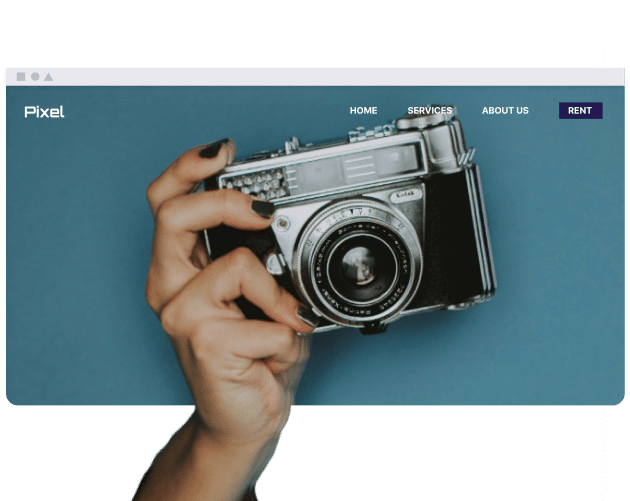Qual è la differenza tra un Hyperlink e un Anchor Link?
Un collegamento ipertestuale è generalmente qualsiasi link che connette una risorsa web a un'altra, come una diversa pagina web, un documento o un'immagine. Un link di ancoraggio, tuttavia, è un tipo particolare di collegamento ipertestuale. È semplicemente un link interno che indirizza a un punto specifico della stessa pagina. Il punto a cui un link di ancoraggio è diretto è chiamato un'ancora, che di solito è un elemento HTML con un ID univoco.
Quali sono alcuni esempi di link di ancoraggio?
Gli anchor link sono una funzionalità standard su molti siti web. Un buon esempio è un “Indice” all'inizio di un post di blog o di una guida completa. Cliccando semplicemente sul titolo, verrai automaticamente reindirizzato alla sezione pertinente più in basso nella pagina. D'altra parte, gli anchor link si trovano su barra di navigazione principale di siti web a pagina singola. Questi elementi consentono il movimento tra sezioni come "Chi siamo", "Servizi" e "Contatti" e possono influenzare lo scorrimento.
Quando dovrei usare i link di ancoraggio?
Se hai un articolo lungo che può essere migliorato utilizzando i link di ancoraggio, allora usali. L'uso di questi strumenti può avere un impatto su articoli lunghi, guide dettagliate passo dopo passo e grandi Pagine FAQ. L'uso di link di ancoraggio in contenuti suddivisi in titoli e sezioni può influenzare l'esperienza dell'utente. Ciò è attribuito alla capacità dei visitatori di navigare tra sezioni distinte, saltando facoltativamente i contenuti che non catturano la loro attenzione.
Quali sono i vantaggi dell'utilizzo dei link di ancoraggio?
I link di ancoraggio possono offrire vantaggi specifici, influenzando l'esperienza dell'utente e l'impatto del contenuto.
• Esperienza Utente: Forniscono ai visitatori un modo per trovare le informazioni in modo efficiente, il che può correlare con i livelli di coinvolgimento e la durata del tempo trascorso sulla pagina.
• Accessibilità: I link di ancoraggio possono influenzare il modo in cui gli utenti con disabilità, in particolare quelli che utilizzano screen reader, navigano una pagina facilitando il movimento tra le sezioni.
• Struttura dei Contenuti: L'implementazione dei link di ancoraggio può guidare logicamente l'organizzazione dei contenuti, influenzando potenzialmente il modo in cui lettori e motori di ricerca ne valutano la struttura.
• La presenza di link di ancoraggio può essere correlata alla facilità con cui gli utenti possono scansionare pagine lunghe, aiutandoli possibilmente a localizzare e scegliere i contenuti.
In che modo i link di ancoraggio influenzano la SEO?
I link di ancoraggio, noti anche come link di salto, influenzano l'ottimizzazione per i motori di ricerca di un sito. Essi influiscono sull'esperienza utente complessiva, che è un fattore nel posizionamento. Il coinvolgimento dell'utente e il tempo trascorso su una pagina, come osservato dai motori di ricerca, possono essere interpretati come un segnale relativo alla qualità dei contenuti. Inoltre, questi link possono essere visualizzati da Google e motori di ricerca simili nei risultati di ricerca, indirizzando potenzialmente gli utenti a informazioni pertinenti. Questo approccio può influenzare il tasso di click e la differenziazione percepita del contenuto rispetto ai concorrenti.
Qual è il codice HTML per un link di ancoraggio?
Per creare un link di ancoraggio, devi avere due componenti separati.
1. L'Ancora: Aggiungendo un attributo ID univoco a un determinato elemento HTML, molto spesso un'intestazione, crei l'ancora. Esempio: <h2 id="”section-one”">Sezione Uno</h2>
2. Il Link: Questo è un tipico <a> tag, ma l'attributo href è accompagnato da #, e poi viene menzionato l'ID della destinazione. Esempio: <a href="/it/”/#section-one”">Vai alla Sezione Uno</a>
Conclusione
I link di ancoraggio sono una funzionalità per la navigazione di pagine lunghe, il che influenza l'esperienza utente. Queste funzionalità consentono agli utenti di navigare direttamente a sezioni specifiche del contenuto, il che può riguardare SEO a causa dei cambiamenti nell'accessibilità della pagina e della possibile presenza di link “salta a” nelle schede dei motori di ricerca. Il processo prevede il collegamento dell'ID univoco dell'intestazione all'href corrispondente di un link.

